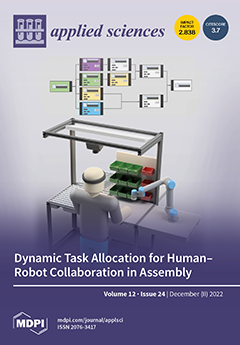This study looks at how incorporating nanofiller into sisal/flax-fibre-reinforced epoxy-based hybrid composites affects their mechanical and water absorption properties. The green Al
2O
3 NPs are generated from neem leaves in a proportion of leaf extract to an acceptable aluminium nitrate combination.
[...] Read more.
This study looks at how incorporating nanofiller into sisal/flax-fibre-reinforced epoxy-based hybrid composites affects their mechanical and water absorption properties. The green Al
2O
3 NPs are generated from neem leaves in a proportion of leaf extract to an acceptable aluminium nitrate combination. Both natural fibres were treated with different proportions of NaOH to eliminate moisture absorption. The following parameters were chosen as essential to achieving the objectives mentioned above: (i) 0, 5, 10, and 15% natural fibre concentrations; (ii) 0, 2, 4, and 6% aluminium powder concentrations; and (iii) 0, 1, 3, and 5% NaOH concentrations. Compression moulding was used to create the hybrid nanocomposites and ASTM standards were used for mechanical testing such as tension, bending, and impact. The findings reveal that combining sisal/flax fibre composites with nanofiller improved the mechanical features of the nanocomposite. The sisal and flax fibre hybridised successfully, with 10% fibres and 4% aluminium filler. The water absorption of the hybrids rose as the fibre weight % increased, and during the next 60 h, all of the specimens achieved equilibrium. The failed samples were examined using scanning electron Microscopic (SEM) images better to understand the composite’s failure in the mechanical experimentations. Al
2O
3 NPs were confirmed through XRD, UV spectroscope and HPLC analysis. According to the HPLC results, the leaf’s overall concentrations of flavonoids (gallocatechin, carnosic acid, and camellia) are determined to be 0.250 mg/g, 0.264 mg/g, and 0.552 mg/g, respectively. The catechin concentration is higher than the phenolic and caffeic acid levels, which could have resulted in a faster rate of reduction among many of the varying configurations, 4 wt.% nano Al
2O
3 particle, 10 wt.% flax and sisal fibres, as well as 4 h of NaOH with a 5 wt.% concentration, producing the maximum mechanical properties (59.94 MPa tension, 149.52 Mpa bending, and 37.9 KJ/m
2 impact resistance). According to the results, it can be concluded that botanical nutrients may be used effectively in the manufacturing of nanomaterials, which might be used in various therapeutic and nanoscale applications.
Full article





